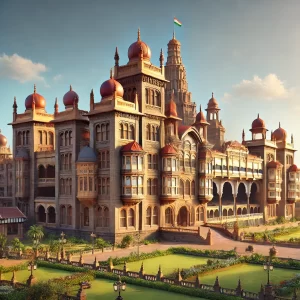Bangalore — the bustling, tech-driven heart of India — isn’t just about innovation and startups. Beneath its modern skyline lies a rich, vibrant history waiting to be explored. From regal palaces to ancient temples, colonial structures, and sprawling gardens, Bangalore’s historical landmarks tell tales of kings, conquests, and cultural transformations.
If you’re a history buff, a curious traveler, or even a local seeking to reconnect with the city’s past, this guide will take you through Bangalore’s must-visit historical gems. Let’s dive in!
1. Bangalore Palace: A Royal Masterpiece
Built in 1887 by Chamaraja Wadiyar, Bangalore Palace is a stunning blend of Tudor and Scottish Gothic architecture, inspired by Windsor Castle in England.
Why Visit?
-
Marvel at the wooden interiors, ornate carvings, and vintage furniture.
-
Explore the Durbar Hall, adorned with vibrant paintings and stained glass windows.
-
Stroll through the palace grounds, now a venue for concerts and cultural events.
Tip: Visit during the early hours to avoid crowds and get those perfect palace photos.
2. Tipu Sultan’s Summer Palace: The Sultan’s Retreat
This elegant teakwood palace, completed in 1791, was the summer residence of Tipu Sultan, famously known as the “Tiger of Mysore.”
Highlights:
-
Admire the Indo-Islamic architecture, intricate floral motifs, and ornate pillars.
-
Visit the museum, which showcases Tipu’s personal items and battle relics.
-
Learn about Tipu’s innovations, including his pioneering use of rockets in warfare.
Did you know? Tipu Sultan’s fort once covered a vast part of Bangalore, but only fragments remain today.
3. Vidhana Soudha: A Symbol of Power and Pride
One of India’s largest legislative buildings, Vidhana Soudha was built in 1956 under K.C. Reddy’s vision, blending neo-Dravidian architecture with traditional elements.
Key Features:
-
The massive structure has 300 rooms, covering 60 acres — all built with granite.
-
It houses Karnataka’s Legislative Assembly and is the seat of state government.
-
Lit up in the evenings, it transforms into a spectacular sight.
Fun Fact: The inscription on the entrance reads “Government’s Work is God’s Work” — a philosophy that shaped its creation.
4. Lalbagh Botanical Garden: A Living Legacy
Founded by Hyder Ali in the 18th century and later expanded by Tipu Sultan, Lalbagh is a 240-acre garden filled with exotic plants and historic monuments.
Why It Stands Out:
-
Home to India’s largest collection of tropical plants and a centuries-old rock formation.
-
The Glass House, inspired by London’s Crystal Palace, hosts annual flower shows.
-
The garden offers a peaceful retreat from the city’s buzz.
Best Time to Visit: Early mornings or during the Lalbagh Flower Show (January and August).
5. Bangalore Fort: A Testament to Time
Originally built as a mud fort by Kempe Gowda I in 1537, it was later transformed into a stone fort by Hyder Ali. Though much of it was dismantled after the British invasion, the remaining parts tell a gripping story.
Key Attractions:
-
Ganapathi Temple, located within the fort’s walls.
-
The Delhi Gate, which served as an entryway for royalty.
-
Remnants of Tipu Sultan’s armory, reflecting Bangalore’s strategic importance.
Pro Tip: Hire a local guide to uncover the hidden stories of the fort’s battles and rulers.
6. St. Mary’s Basilica: The Oldest Church in Bangalore
Built in 1882, St. Mary’s Basilica stands as a stunning example of Gothic architecture and holds deep religious significance.
What Makes It Special?
-
Towering stained-glass windows and majestic arches create a serene ambiance.
-
It’s Bangalore’s only church to be elevated to the status of Minor Basilica by Pope Paul VI.
-
The St. Mary’s Feast in September draws thousands of devotees and tourists.
Photo Tip: Visit in the evening to capture its illuminated façade.
7. The Bull Temple: Home to Bangalore’s Giant Nandi
Built by Kempe Gowda I, this temple houses a 15-foot-tall Nandi (the sacred bull of Lord Shiva), carved from a single granite rock.
Must-See Details:
-
The bull mysteriously darkened over time — locals believe it’s due to continuous oil offerings.
-
The Kadalekai Parishe (Groundnut Festival) is held annually, celebrating the local legend surrounding the temple’s creation.
Local Legend: Farmers believe the bull protected their crops from destruction!
8. Cubbon Park: Bangalore’s Green Heart
Established in 1870 by Sir John Meade, this 300-acre park is a colonial-era legacy with tree-lined avenues, statues, and historical structures.
What to Explore:
-
Attara Kacheri (High Court) — a striking red Gothic building inside the park.
-
Statues of Queen Victoria and King Edward VII.
-
Peaceful walking trails perfect for a morning stroll.
Travel Tip: If you’re exploring Vidhana Soudha, this park is right next door!
Final Thoughts: Bangalore’s Timeless Charm
Bangalore may be renowned as India’s technology capital, but its soul lies in its heritage and history. Each landmark whispers a story — from royal grandeur to colonial imprints and ancient traditions.
?So, why visit Bangalore?
Whether you’re a history enthusiast, an architecture admirer, or a traveler seeking diverse experiences, Bangalore’s historical landmarks offer something unforgettable.
Which of these landmarks are you most excited to visit? Let us know in the comments!


